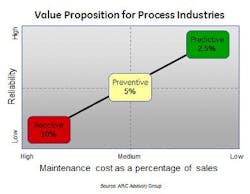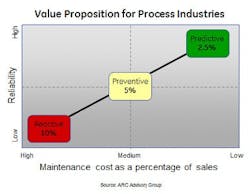Proactive maintenance reduces the risk of safety incidents
With motors serving as the driving force behind production systems across a wide variety of industry sectors – including manufacturing, mining, oil and gas, and water supply – it is of the utmost importance that plant managers select a maintenance strategy that will ensure decreased downtown of critical motor systems. The majority of plant managers practice one of three maintenance strategies for key assets, including motors.
Run to failure/reactive: fix assets once they fail, but do not perform regularly scheduled maintenance. Typically, managers that implement this strategy forfeit capital and schedule from periodic maintenance and equipment removal efforts.
Preventive: schedule planned maintenance actions aimed at the prevention of breakdowns and failures. This approach does not consider specific operating conditions and can lead to unnecessary maintenance costs, or worse, under-maintenance of assets.
Predictive: monitor the condition of assets on an ongoing basis to forecast future performance and predict when maintenance should be scheduled.
[pullquote]
According to the U.S. Department of Energy, approximately 86% of plant managers characterize their present maintenance strategy as “reactive” or “preventive.” However, more times than not, these managers would be better served to consider making a change to a predictive maintenance strategy. In fact, plant managers that practice a predictive maintenance strategy enjoy extended equipment life expectancy; lower probability of unplanned outages (every hour of unplanned downtime cost operators $100,000, according to the Industrial Productivity Training Manual, 1996 Annual IAC Directors’ Meeting, Rutgers University, U.S. Department of Energy Office of Industrial Technologies); 10-15% gains in operating efficiency, according to Pacific Gas and Electric’s 1997 Application Note: Efficiency Opportunities Through Motor Maintenance; and reduced employee exposure to potential safety hazards. In looking at safety benefits more closely, research presented at the Paper Industry Management Conference in 2003 indicates that industrial facilities are 28% more likely to have a safety incident when maintenance work on a motor is reactive versus planned.
Transitioning to a predictive maintenance approach
Transitioning to a predictive approach can be achieved through the implementation of a remote monitoring and diagnostic (RM&D) service. An RM&D service for industrial facilities utilizing motor equipment in their applications samples voltage, current, temperature and vibration data and transmits the values via a secure or cellular network connection to a remote monitoring center. At the center, experienced industrial engineers are informed of erratic machine behavior, allowing for preventive maintenance, permitting condition-based service or halting dangerous operation. RM&D also enables users to analyze motor operating trends through a secure Web connection, which maintains all condition data for real-time inspection.
Other advantages of an RM&D service are 24/7 monitoring, which includes the ability to analyze trending patterns to help identify possible failure models undetected by motor relays; Web-based plant operator access to current and historical motor performance records, as well as immediate alert notifications; and wireless connectivity to ensure network security via a one-way cellular connection, while avoiding infrastructure firewall restrictions and network cabling costs.
After considering all of these factors and successfully converting to a predictive maintenance strategy, plant managers will have greater control over the success of numerous critical job responsibilities, including ensuring safety of personnel, staying within budget and maximizing the efficiency and life-span of the motors that support their facilities.
Brian Anulies is strategic marketing manager for GE Energy Industrial Solutions (www.geindustrial.com). Email him at [email protected].

